Outputting 305 oz-in and transiting in 0.07 sec/60° the DS305CLHV standard-size digital servo is ideal for many models. In baseball, this servo would be the utility infielder because it's so versatile. Helicopter pilots love it, so do IMAC competitors, and 3D guys where it often finds a home on the control surfaces of 74-84" wingspan aircraft because it's fast enough to move them from one extreme to the other - an arc of 90°or better - in basically the blink of an eye! Since 300+ ounces (or 19 lbs) is more than the model probably weighs, we're talking about enough torque to muscle it through maneuvers like a Wall or Terminator when finesse won't do the job!
Of course, if IMAC maneuvers are your passion, it's all about finesse. Two questions top your mind; how well it centers and what does it weigh? With respect to centering, due to
our using a genuine
Japanese Nobel potentiometer (the best money can buy) along with
MIL-SPEC
components, you get the best centering in the industry.
And since the case is made of CNC-machined aircraft aluminum plus impact
resistant engineering polymer (reinforced with bronze bushings at the
steel gear shafts pockets), you get lust-worthy light weight plus
slop-free performance that endures season after season.
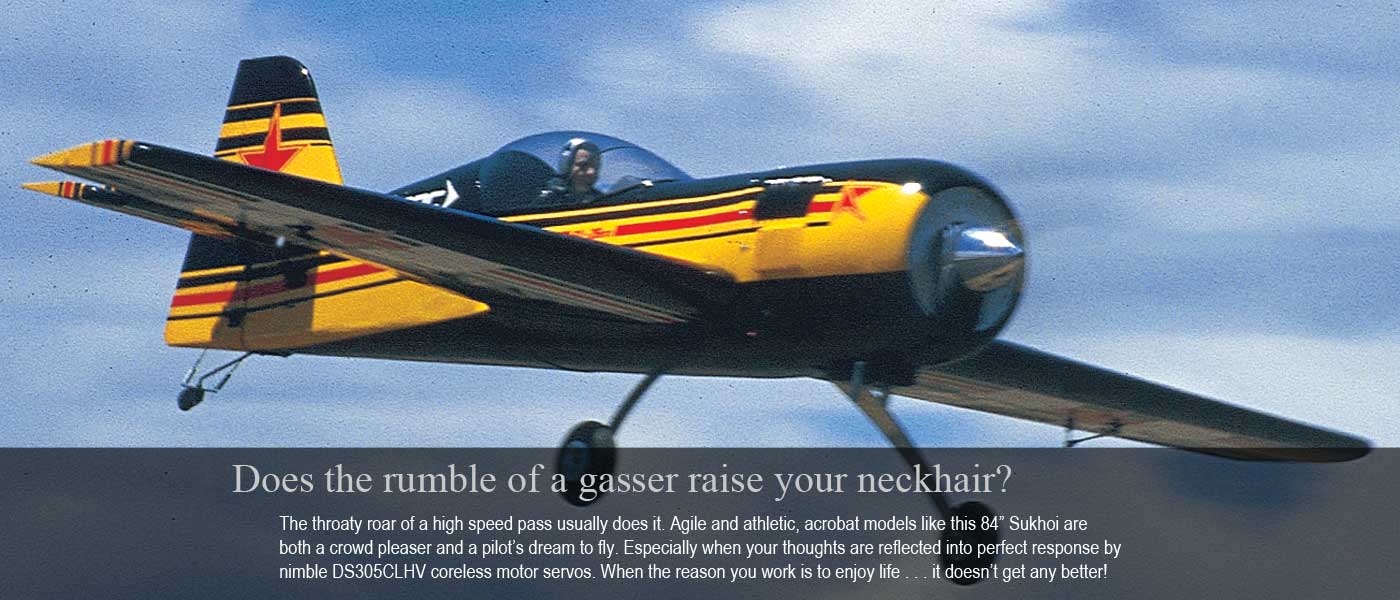

Racing an 1/8th scale stadium truck or buggy means you need a lot of torque to carve turns precisely - regardless of track conditions. But you also have to have enough quickness to respond to the antics of tricky competitors trying to block your pass. You get all this, and more, with the DS305CLHV - plus it's lightweight and tough. The perfect servo for racing? Yup, could be!

Accomplished pilots of 600 to 800-class helicopters, like a Pantera P6 or an SAB Goblin, love coreless motor servos because of their power and how quickly they respond. Sure, faster cyclic servos are where it's at for quicker 3D maneuver, but scale modelers love the DS305CLHV for the power to handle multi-rotor heads and heavy models. Also important are how this servo is built with an aluminum center case plus reinforced-polymer components - lighter for when grams are important!
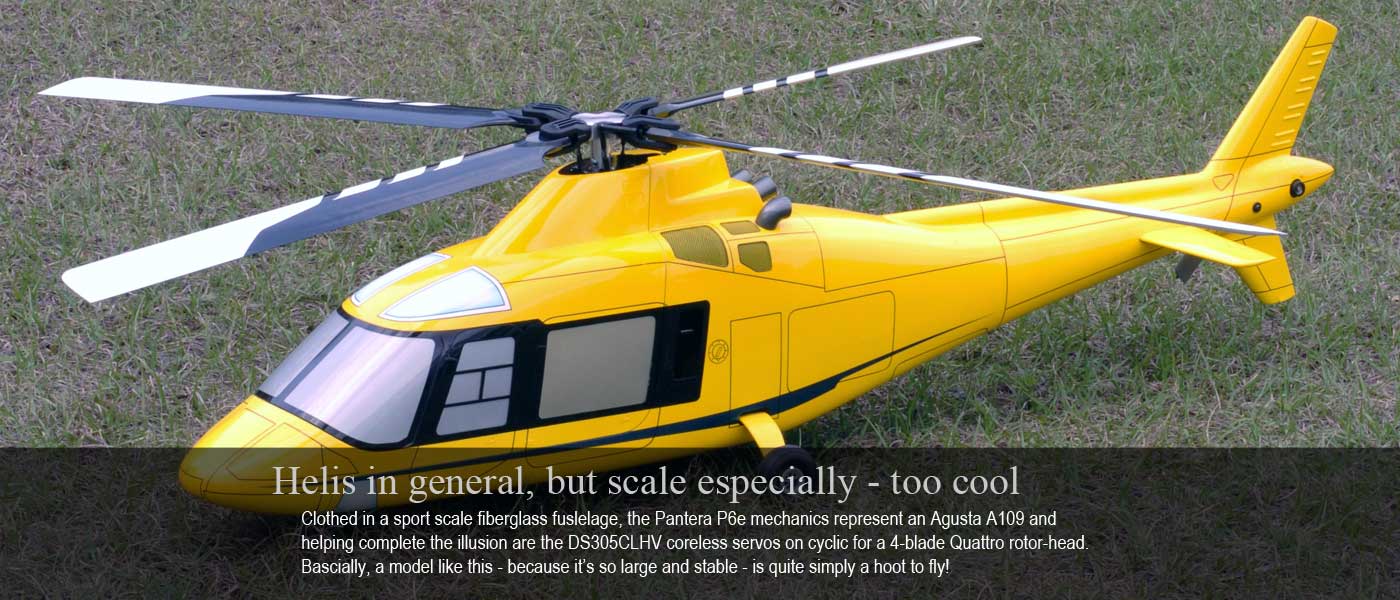

You've spent months or years building out a scale warbird. We're speaking about the kind of model where the rigors of competition often mean burying a servo beneath scale detail (such that it's basically inaccessible). Since it's not a hangar queen, when you put hundreds (or thousands) of hours of labor at risk by taking wing, servos the caliber of the DS305CLHV will give you peace of mind.

We said the DS305CLHV is like a utility infielder where instead of being a good shortstop, 2nd baseman, or deftly planting a foot on 1st, it gets the job done very nicely in scale models, pattern planes, IMAC as well as 3D, plus helicopters, and racers! Better components.
Better servos. The formula is simple. Decisions regarding what go into
ProModeler servos aren't made in accounting to optimize price
and profit, but in engineering. The reasonable price
comes about because of a better business model that eschews the old way
of doing things (importer + distributor + hobby dealers) because they
all get a cut at your expense. With us you cut out the
middlemen by dealing direct.

Note: operating voltage is
4.8-8.4V, but optimal performance is obtained with a 2S LiPo instead of a
BEC. This is because LiPos deliver the required current without
voltage spikes, noise, or otherwise adversely affecting the delicate
avionics (25C or better is recommended). After all, synthetic orange-colored Tang may have gone to the moon, but it doesn't compare to freshly squeezed orange juice, right? The same holds true when it comes to feeding your avionics!
Other Resources
For detailed specifications and dimension drawings, select the Specs tab above. Also, there's an even-handed look at the competition in the Comparison tab so don't overlook this one.
Note; when the trade off between money for a little more torque (plus a significant increase in speed) is attractive, eyeball our DS345BLHV
because it's basically the same physical size but outputs 345 oz-in at an über speedy 0.05sec/60° - this servo is actually faster than the blink of an eye - believe it, or not! Super aggressive 3D pilots especially love this servo (if their pockets are deep enough because these puppies go for
about 100 bucks a pop). Of course, this means they're not for everybody, but if an
all-aluminum case plus a brushless motor is your cup of tea, then these are the very best we know how to make. As befits the bespoke flagship of our lineup, it's made for those who want the
very best . . . and hang the expense! You know who you are.
When customers mention a competing servo, they're basically asking our opinion regarding how something else compares to our DS305CLHV. What follows is a summary of our observations - offered in hopes of informing your opinion (while trusting you'll judge us to be blunt, but fair).
With so many standard size coreless-motor servos available, selecting the best one can be hard. This page compares and contrasts the ProModeler DS305CLHV digital servo with others vying for your business. While not a comprehensive market survey because we've been careful to winnow out the junk, these are ones we - as modelers - would consider buying if we weren't in the servo business ourselves. Note, despite the fact some are more powerful, and one a bit less, they're all about equal in torque and more expensive than ours, so they're shown because we're not afraid of a fair fight). Servos are listed alphabetically.
- Futaba S9156 - $129.99
- Hitec - HS-7955TG - $99.99
- JR - S8411HV - $124.99
- MKS HV1220 - $89.99
- Savox SC-1256TG - $69.99

The Futaba S9650 has long been a favorite of sport pilots. It's especially popular with giant scale modelers because it offers 340oz-in of torque (a good 10% more than our own DS305CLHV offers). However, we wipe the floor with them speed-wise because at 0.07 sec/60° ours is about 250% faster than theirs at 0.17sec/60° - and yes, more than twice as fast is a game changer! Especially if you're into flying 3D aerobatic models with a 76-78" wingspan range like an Edge 540 or Extra 300. Ditto if you're competing with a 2M pattern plane, an 1/8th scale stadium truck, and especially a 700-class 3D helicopter because their servo is just too slow. Regarding the 10% difference in torque, there are two ways to look at this. First, if your budget extends to $129.99, look at our DS345BLHV instead. What it brings to the table is 345oz-in of torque, plus 0.05sec/60° speed, an all-aluminum case, and a brushless motor. Frankly, this servo completely outclasses the S9156 (to the point it's no contest) and while it's also a lot more expensive than our DS305CLHV, the Futaba S9156 is still 30% more expensive than this, our flagship servo! Second, in the real world (especially if your money doesn't grow on trees), experienced pilots know there's little practical difference between 305-340oz-in, and thus, if speed and price enters the equation, it's all over but the crying. However, there's more because the DS305CLHV has really sweet construction features like a conformal coating on the PCB. This better protects the delicate electronic components from destructive vibration and shock. Add to it, the DS305CLHV is assembled with 10 hardened (grade 12.9) Allen head machine-thread bolts instead of 4 Phillips-head screws.Plus ours has 13-orings for making it water resistant, and our middle case is fully CNC-machined from a solid billet of 6061-T6 aircraft aluminum instead of using an aluminum extruded (the way aluminum window profile are made). The mere fact ours has cooling fins makes a huge difference in terms of shedding heat better when working the servos hard because you're flying hard. Consider the difference in price and we basically seal the deal with experienced modelers.
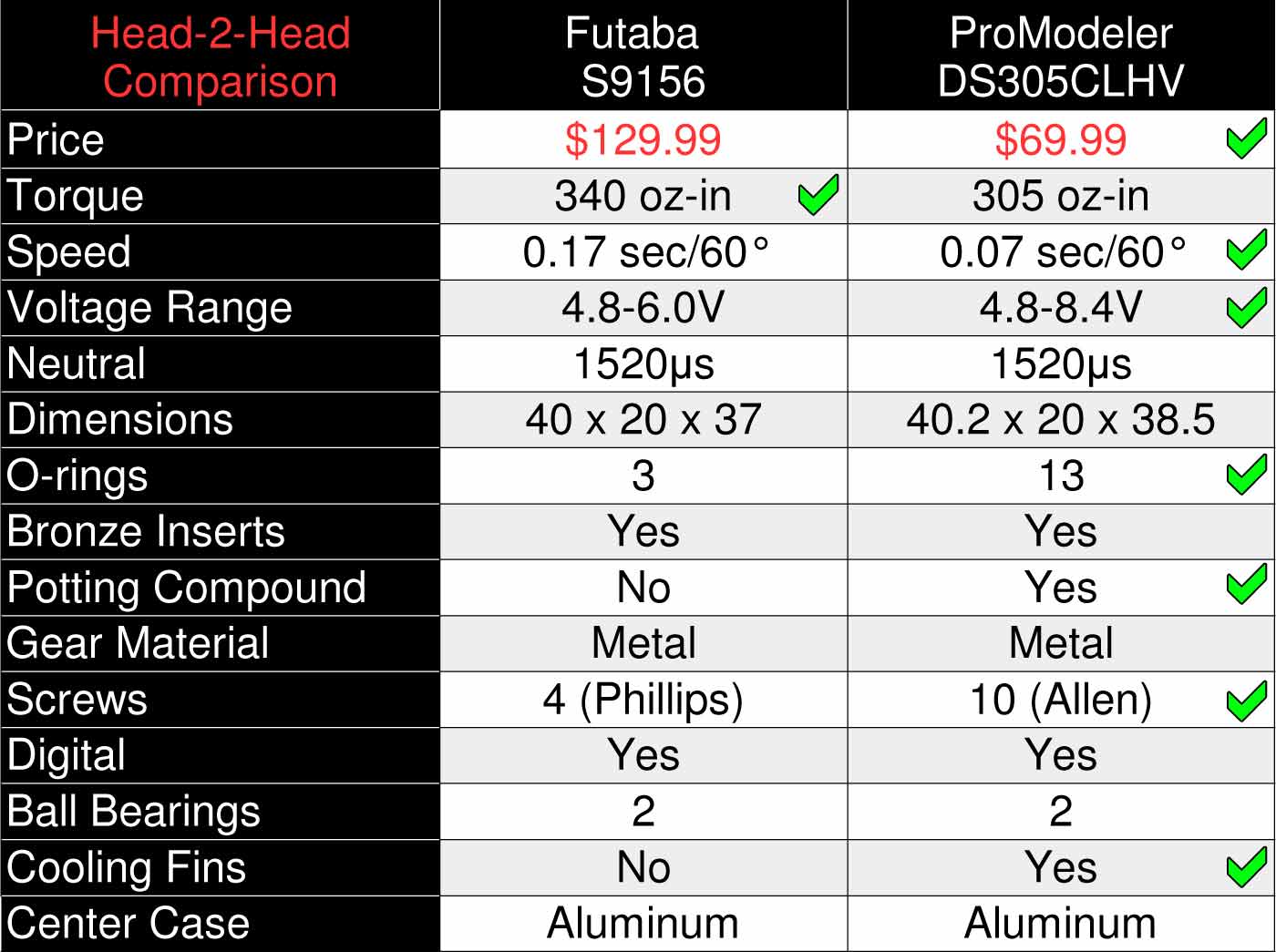

A lot of pilots think highly of the Hitec HS-7955TG - and with good reason because it's a solid product with a good reputation. While it's admittedly got a little more torque than the DS305CLHV (333 vs 305oz-in), we clean their clock in the speed department because ours at 0.07 as compared to theirs at 0.15sec/60° is more than 2X faster! If you're an experienced pilot you're probably thinking . . . "Wow, a tad bit less torque but twice as fast? That wins in my book!", and most pros will agree because this is such a huge speed advantage it's something even rookie pilots easily feel. But it goes further than that because once you look at how well built the DS305CLHV servo is, you're going to be hard pressed to justify theirs. For example, if you look at the shallow grooves in the HS-7955TG aluminum middle case, it dawns on you how you're looking at something spaced like cooling fins, but then you realize they look an awful lot like a decoration. Now, eyeball our middle case. It's easy to see this isn't just an aluminum extrusion but has instead been CNC-machined from a solid billet of 6061-T6 aircraft aluminum. Basically, our cooling fins are real and if you fly hard these make all the difference because flying hard means the motors is generating more heat (and heat really stresses the motor and associated electronics). And this is just what you can see without opening up the servo! Thing is, it's inside where the DS305CLHV really shines. For example, we protect the PCB (printed circuit board) with potting compound (what's called a conformal coating in military parlance). This sticky stuff is something we call monkey snot, but it offers more protection against shock and destructive vibration. Especially as compared to maybe a little piece of foam rubber. Plus we use real bolts, with nice Allen-heads. They're hardened too (grade 12.9) as compared to ordinary Phillips head screws. Moreover, they sandwich their aluminum assembly together with just 4 versus of those things (and they just thread into plastic). Meanwhile the DS305CLHV assembly uses 10 machine bolts that are thread into metal. We use ten bolts because it results in a more rigid assembly. maybe this won't matter this year or next but in ten years when you haven't had to replace the case for excess slop you'll be happy, believe it! Anyway, it's pretty simple; which would you rather have; Phillips head screws where if the tool slips it may jab you with a pointed end and draw blood, or an Allen driver that locks into the bolt head? Not a very hard decision, is it? Also hidden from view are the 13 O-rings we use to protect your investment - after all, who can predict the future? Perhaps some day you want to go float flying, right? Or maybe you land after getting caught in a summertime pop-up rain shower. One that totally drenches your model and the servos. This is a real consideration and can be a big deal what with the popularity of direct control (e.g. where servos are installed beneath the stabs). So with DS305CLHV servos you're ready to rock and roll if moisture is a consideration instead of facing the need of buying servos again. Last thing is when you look at the price difference. That's when you suddenly you realize we've playing at a whole new level. Yes, we've changed the game and everybody else better step up or they'll be left behind. Anyway, while we think it's a slam dunk decision, what matters is what you think. If you like our attention to detail, and appreciate what we're doing in trying to make our servos better for you - and at the same time - better for your wallet we hope you'll opt for our servos for your next model.
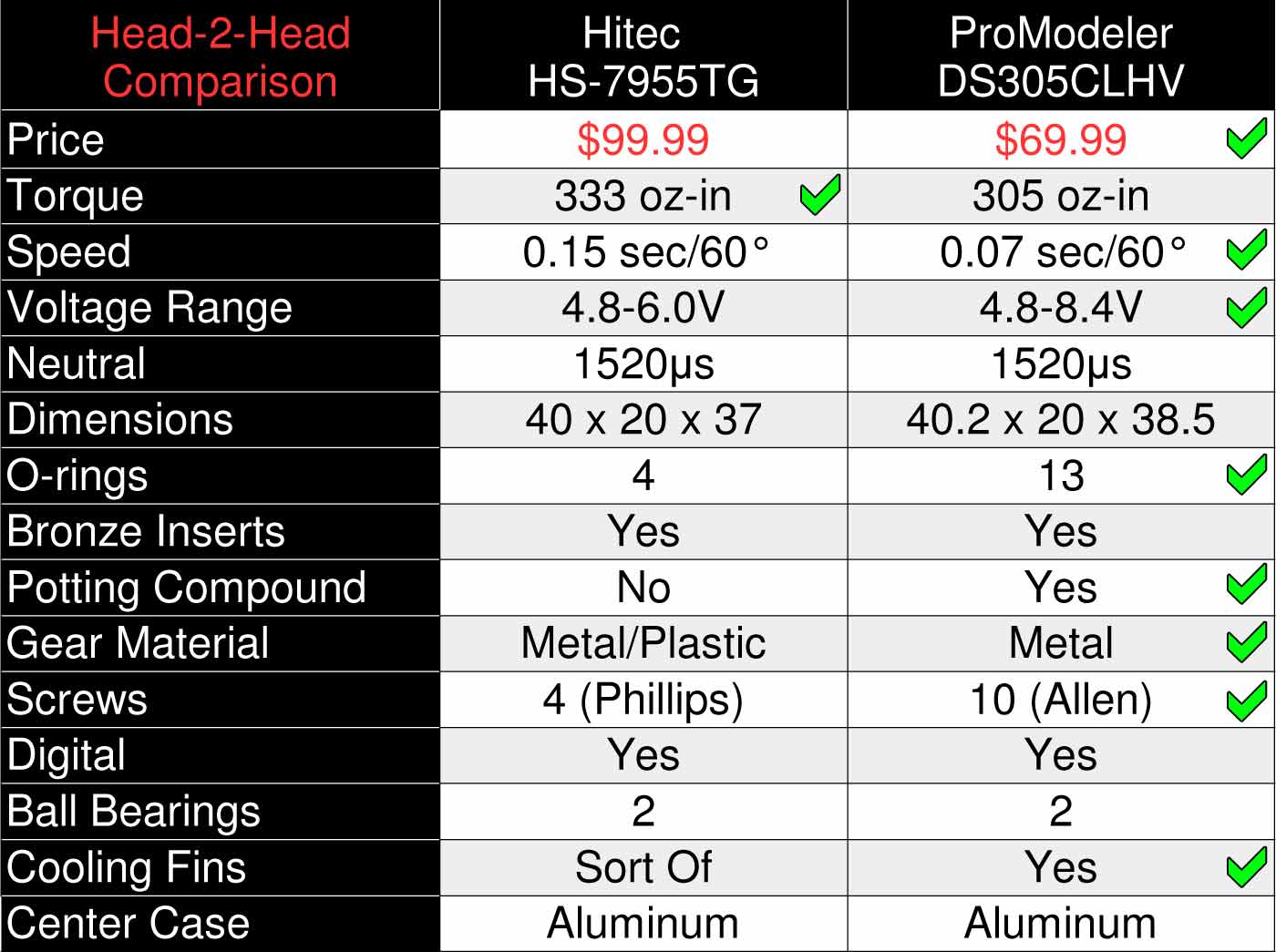
 JR has been in the business of making high quality servos for a long time. The S8411HV is a refinement of their very well regarded S8411 and some may wonder why we include it since it only make 240oz-in versus our 305oz-in. Thing is, we're experienced modelers and like you, we don't think there's a heck of a lot of difference (in the real world) between 15lbs of force vs.19lbs of force. Not when you're talking about one servo for one control surface for a model weighing less than 20 pounds! However, what make a huge difference, especially if you're interested in high performance, is that ours is a heck of lot faster. And it's a big difference too, because ours transits 60° in 0.07 sec while theirs does it in 0.15 seconds . . . so were talking more than twice as fast. Look, this is really simple. If you're trying your hand at a torque roll, or a waterfall, then the control surface powered by their servos moves really slowly as compared to ours. And beyond higher performance, our construction is considered to be really, really good because, for example, we use 13 O-rings to protect it against water and fuel intrusion. We also have a middle case that's CNC-machined from a solid billet of 6061-T6 aircraft aluminum - complete with cooling fins - while theirs is plastic. This is super important when you're flying hard because that's precisely when the motor is generating the most heat (and shedding it is the job of the aluminum). Moreover, we go the extra mile to protect the PCB (printed circuit board) against impact shock plus vibration by applying a conformal coating. This, by the way, is how they do things within aerospace components (and if it's good enough for them, then it's the standard at ProModeler as well). Why? Basically because we're modelers like you and thus, we actually know what the stakes involved are when a pilot is flying a high performance remote control model. Finally, their servo is nearly twice as expensive as ours, and this isn't a knock on them but simply a reflection of the fact that with us you're dealing direct instead of going through distributors and hobby dealers (who all have to take their cut because everybody has to eat). In any case, that's how the world of retail works and instead of fighting it, we've embraced it. Finally, with respect to which servo is better for you? We hope you like what we're bring to the table and go with us for your next set of servos.
JR has been in the business of making high quality servos for a long time. The S8411HV is a refinement of their very well regarded S8411 and some may wonder why we include it since it only make 240oz-in versus our 305oz-in. Thing is, we're experienced modelers and like you, we don't think there's a heck of a lot of difference (in the real world) between 15lbs of force vs.19lbs of force. Not when you're talking about one servo for one control surface for a model weighing less than 20 pounds! However, what make a huge difference, especially if you're interested in high performance, is that ours is a heck of lot faster. And it's a big difference too, because ours transits 60° in 0.07 sec while theirs does it in 0.15 seconds . . . so were talking more than twice as fast. Look, this is really simple. If you're trying your hand at a torque roll, or a waterfall, then the control surface powered by their servos moves really slowly as compared to ours. And beyond higher performance, our construction is considered to be really, really good because, for example, we use 13 O-rings to protect it against water and fuel intrusion. We also have a middle case that's CNC-machined from a solid billet of 6061-T6 aircraft aluminum - complete with cooling fins - while theirs is plastic. This is super important when you're flying hard because that's precisely when the motor is generating the most heat (and shedding it is the job of the aluminum). Moreover, we go the extra mile to protect the PCB (printed circuit board) against impact shock plus vibration by applying a conformal coating. This, by the way, is how they do things within aerospace components (and if it's good enough for them, then it's the standard at ProModeler as well). Why? Basically because we're modelers like you and thus, we actually know what the stakes involved are when a pilot is flying a high performance remote control model. Finally, their servo is nearly twice as expensive as ours, and this isn't a knock on them but simply a reflection of the fact that with us you're dealing direct instead of going through distributors and hobby dealers (who all have to take their cut because everybody has to eat). In any case, that's how the world of retail works and instead of fighting it, we've embraced it. Finally, with respect to which servo is better for you? We hope you like what we're bring to the table and go with us for your next set of servos.
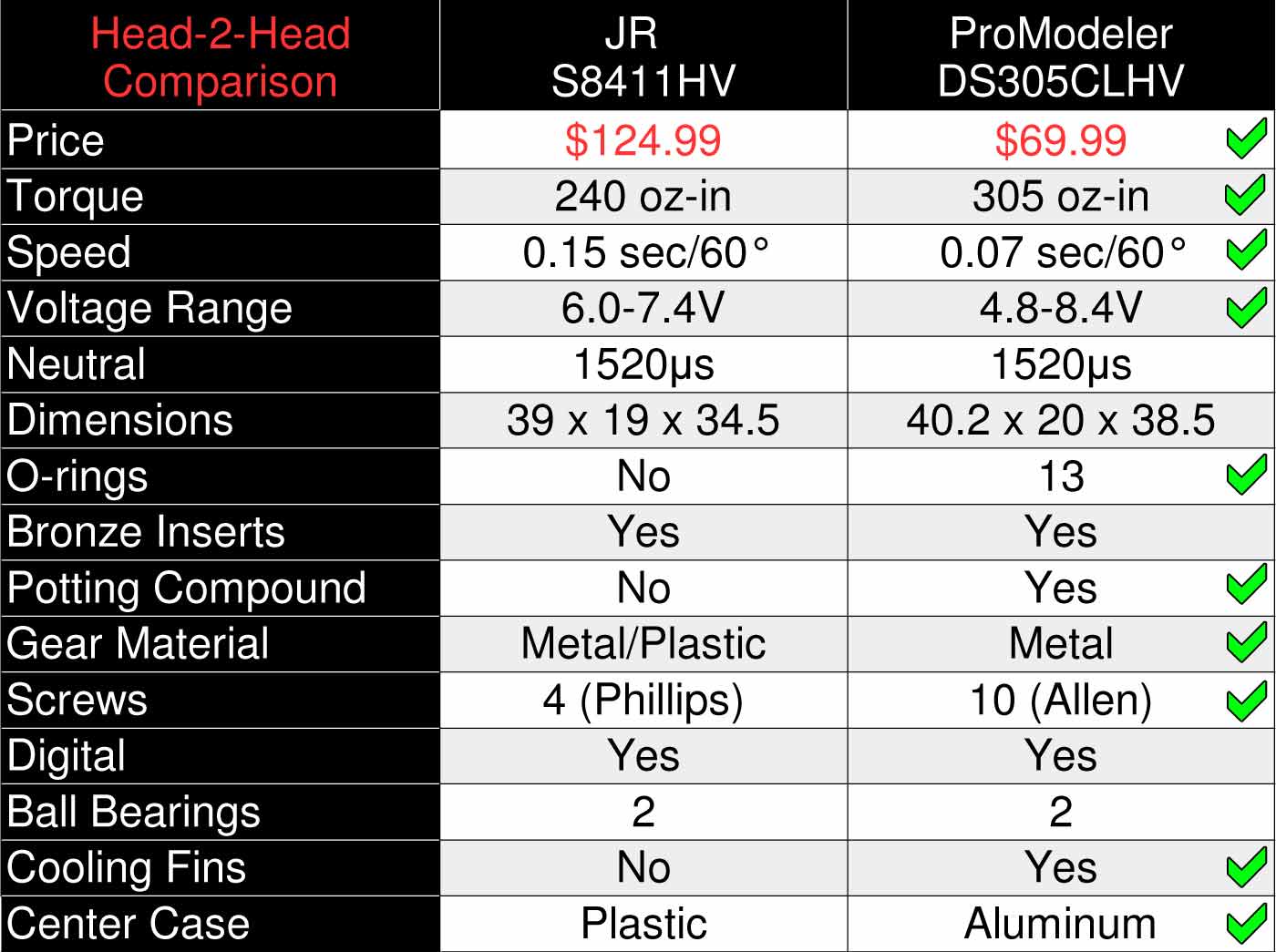

The MKS HV1220 is an excellent servo for the club pilot because it's well made and reliable. However experienced competition pilots may judge the DS305CL a better value - despite the HV1220 being 5% stronger - because the DS305CLHV is faster (a lot faster). And faster is especially important for pilots of 700-class 3D helicopters because it means completing cyclic maneuvers more quickly. Similarly, drivers of 1/8th scale racers benefit from quicker steering that lets you dive deeper into corners to make the pass. And of course, pilots of hyper aggressive 3D acrobats of about 78-82" wingspan benefit because when you're moving a huge control surface from one extreme of travel to the other, it happens 60% slower with the MKS HV1220. Do you who want slower servos? But there's more; for example, would you agree the very purpose of buying a high performance servo is being able to work it hard? Working it harder means generating more heat, and because the DS305CLHV center case has cooling fins, it sheds heat better. This is a thermodynamic advantage that also happens to result in a significantly longer motor life. This has been engineered into our product from the get-go because decisions about performance aren't made in accounting. This is why you get a fully CNC-machined center case instead of the less expensive to produce aluminum extrusion. One that result from hogging out a solid billet of aircraft aluminum. Frankly, the other way (extruded) is more akin to how window frames are squeezed through a die to form a shape. Our way means you get cooling fins. Their way? Not! One way relies on four screws threaded into plastic to sandwich the assembly together. Our way depends on fine-thread machine screws (all of them threaded into metal). Which do you think is better? But there's more because if you eyeball the electronics, you see that we use a genuine Japanese Nobel potentiometer ( the best money can buy). And the PCB (printed circuit board) of the DS305CLHV has a conformal coating because it helps it resist shock and vibration better. And remember the fasteners we mentioned earlier? They use 6-Phillips screws while we use 10 hardened (grade 12.9) Allen-head machine bolts. Yes, it's a small touch but it's one you'll love if you've ever had one of those darned pointy Phillips screwdrivers slip and draw blood! Bottom line? Only you can judge what use you can make of a faster servo like ours, but everybody benefits from better cooling, better fasteners, and better protection against destructive vibration. Last thing. Consider how ours saves you 20% and if you're thinking it's game, set, match . . . then we agree! Anyway, check out the chart below to see how these two servos compare head-2-head.
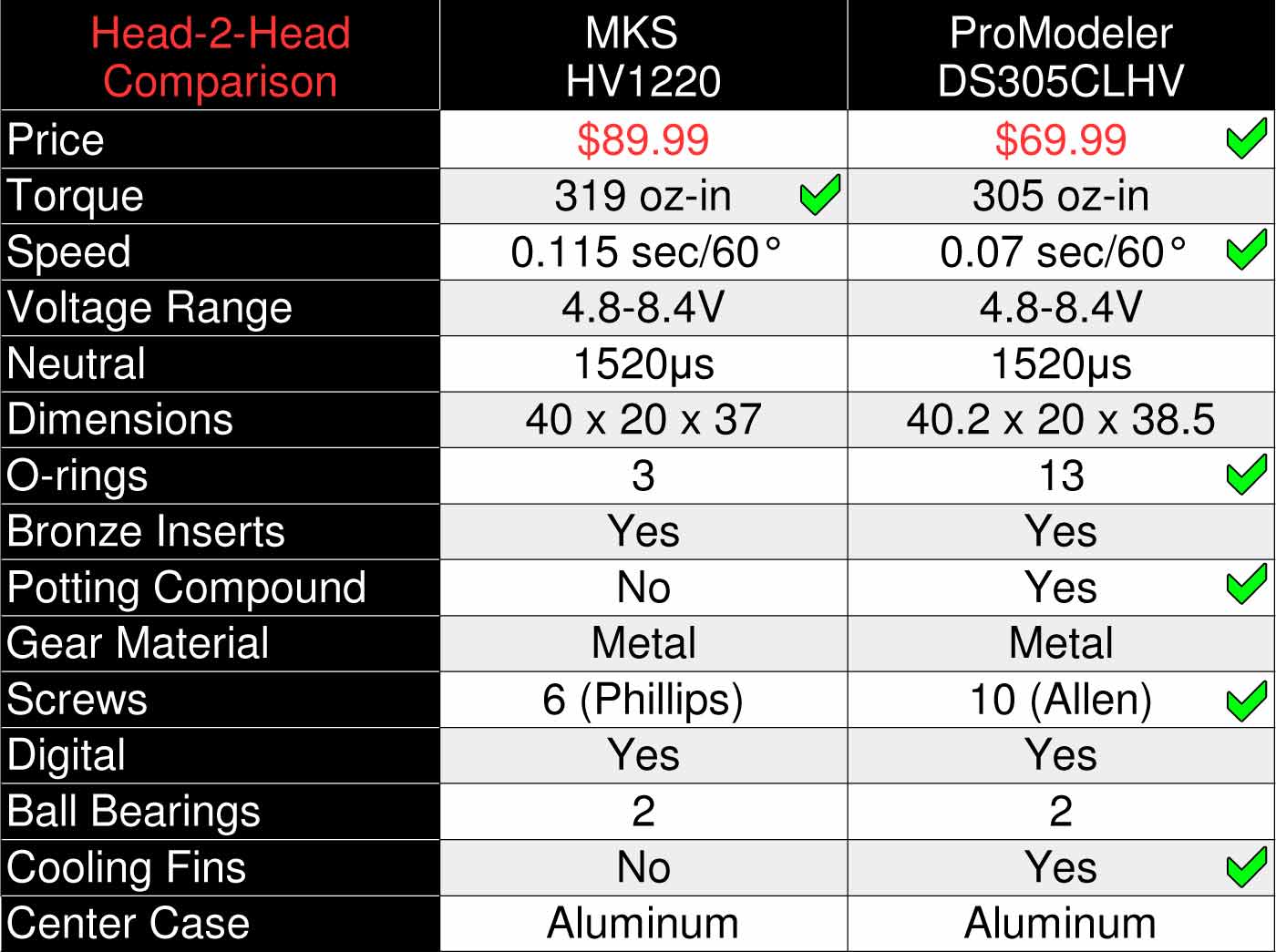
 The Savox SC-1256TG is a solid competitor in the market for your business and is favored by pilots familiar with Savox's established reputation. That said, the DS305CLHV is more versatile in terms of voltage input, is a tad more powerful, and a whole lot faster. The DS305CLHV will likely prove more durable due to the being equipped with bronze bushings. These reinforcing the polymer case where the steel gear shafts fit within the pockets. This means you get you the long wearing durability of an all-metal case combined with the lightweight of an engineering polymer case. This is clearly a win-win also. Especially once you consider the aluminum middle case of the Savox is extruded while that of the DS305CLHV has been CNC-machined from a solid billet of 6061-T6 aircraft aluminum. This gives you several advantages like cooling fins that let the motor shed heat better when it's being worked hard, plus the fact the assembly screws all thread into metal (unlike the Savox SC-1256TG where the merely pass through the metal and thread into the plastic top case). In effect, with the Savox style of construction, the metal center case is merely sandwiched between the three plastic pieces. Meanwhile, the DS305CLHV has six bolts securing the top, (or transmission section) to the hefty aluminum and this is better because it results in a stiffer case assembly. But there's more because the DS305CLHV also has a conformal coating (potting compounds we call monkey snot because it's a sticky mess to work with until it dries) applied to the PCB (printed circuit board) for impact (shock) resistance and vibration protection at a level seen in military and aerospace grade hardware. Combined with 13 O-rings sealing the assembly against dust and water intrusion, your investment is well protected. Basically, in this head-2-head comparison, the DS305CLHV has stacked the deck in your favor from the onset because it's built better due to better components, is stronger, and a lot faster. How much faster? How does 2X faster strike you? Fast enough to deflect back and forth in the time the Savox takes to go in one direction only. we're talking about a serious performance advantage for the accomplished pilot and pretty much a no brainer in our opinion - but we're biased so you'll have to eyeball the comparison chart and judge for yourself.
The Savox SC-1256TG is a solid competitor in the market for your business and is favored by pilots familiar with Savox's established reputation. That said, the DS305CLHV is more versatile in terms of voltage input, is a tad more powerful, and a whole lot faster. The DS305CLHV will likely prove more durable due to the being equipped with bronze bushings. These reinforcing the polymer case where the steel gear shafts fit within the pockets. This means you get you the long wearing durability of an all-metal case combined with the lightweight of an engineering polymer case. This is clearly a win-win also. Especially once you consider the aluminum middle case of the Savox is extruded while that of the DS305CLHV has been CNC-machined from a solid billet of 6061-T6 aircraft aluminum. This gives you several advantages like cooling fins that let the motor shed heat better when it's being worked hard, plus the fact the assembly screws all thread into metal (unlike the Savox SC-1256TG where the merely pass through the metal and thread into the plastic top case). In effect, with the Savox style of construction, the metal center case is merely sandwiched between the three plastic pieces. Meanwhile, the DS305CLHV has six bolts securing the top, (or transmission section) to the hefty aluminum and this is better because it results in a stiffer case assembly. But there's more because the DS305CLHV also has a conformal coating (potting compounds we call monkey snot because it's a sticky mess to work with until it dries) applied to the PCB (printed circuit board) for impact (shock) resistance and vibration protection at a level seen in military and aerospace grade hardware. Combined with 13 O-rings sealing the assembly against dust and water intrusion, your investment is well protected. Basically, in this head-2-head comparison, the DS305CLHV has stacked the deck in your favor from the onset because it's built better due to better components, is stronger, and a lot faster. How much faster? How does 2X faster strike you? Fast enough to deflect back and forth in the time the Savox takes to go in one direction only. we're talking about a serious performance advantage for the accomplished pilot and pretty much a no brainer in our opinion - but we're biased so you'll have to eyeball the comparison chart and judge for yourself.
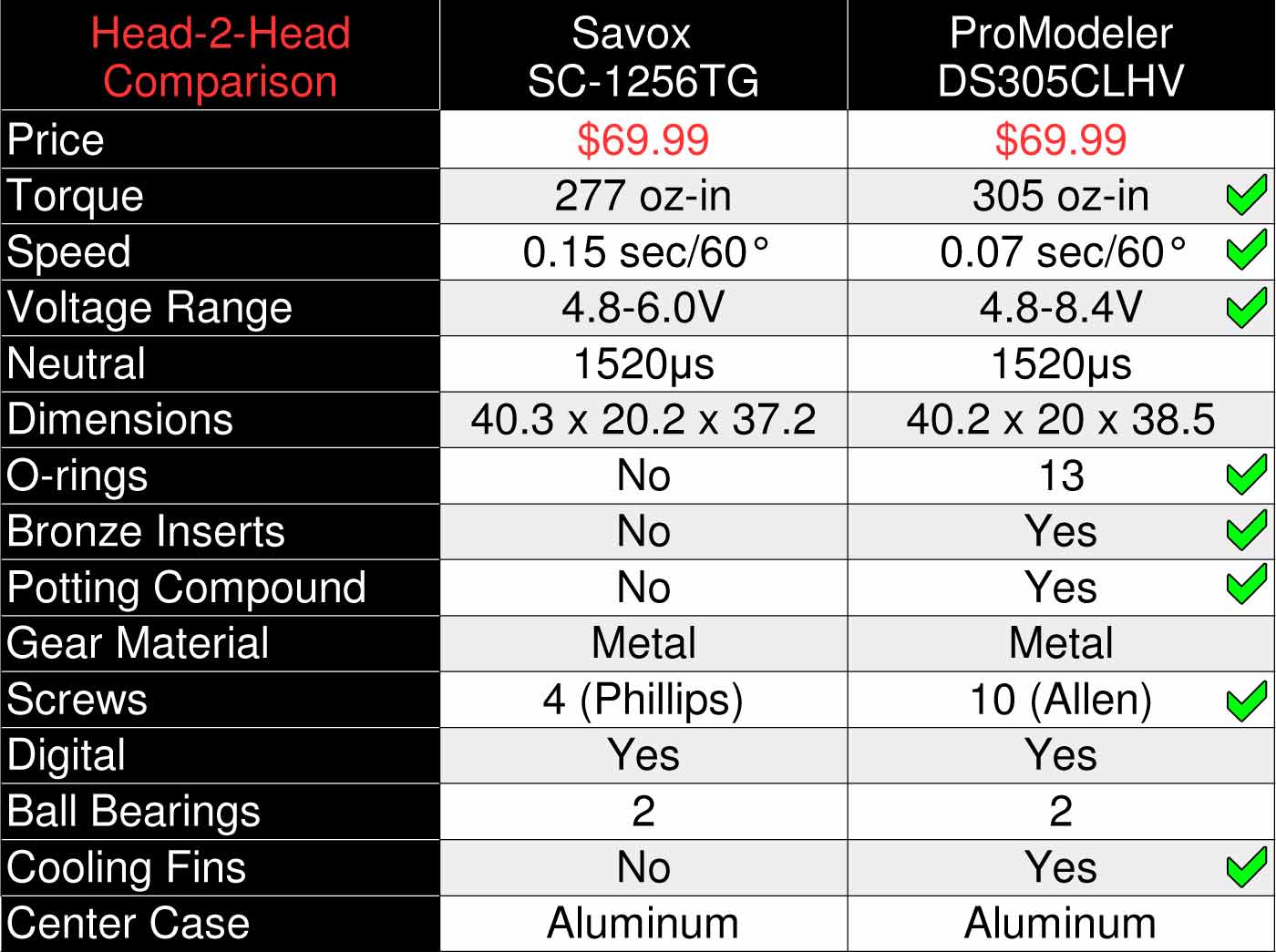

Have we been fair, or unfair in our assessment? Have something to
add? Perhaps you have a question we haven't answer. Fire away because
we're here to help!